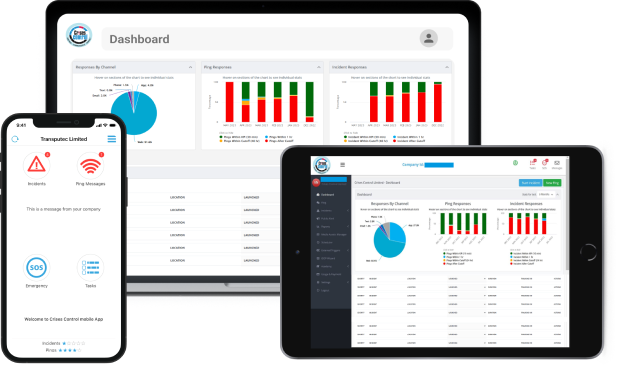Written by Anneri Fourie | Marketing Executive
In an emergency, every second counts. For businesses, the ability to respond quickly and effectively during a fire can be the difference between safety and catastrophe. Having a well-crafted fire evacuation plan is essential—it’s not just about compliance, it’s about ensuring the safety of your employees and minimising damage. Yet, creating an effective fire evacuation plan can feel overwhelming, especially when you’re trying to prepare for the worst while running a business.
This is where incident management software with real-time alerts, like Crises Control, comes in. With the right tools, you can create a comprehensive evacuation plan that’s easy to follow, saves time, and keeps everyone informed when it matters most.
In this blog, we’ll walk you through the seven steps to create a fire evacuation plan and highlight how Crises Control can streamline the process.
1. Assess the Risks and Identify Fire Hazards
The first step in creating a fire evacuation plan is understanding what could go wrong. Look around your workplace and identify potential fire risks. This could include flammable materials, overloaded electrical outlets, or machinery that could overheat. A thorough assessment helps you pinpoint hazards before they become emergencies.
Best Practices
- Regularly inspect electrical equipment and wiring for faults.
- Identify flammable materials and store them safely.
- Conduct routine checks to ensure fire safety equipment is in good condition.
How Crises Control Can Help
Crises Control’s Incident Manager module allows you to document hazards digitally, categorise them based on severity, and prioritise corrective actions. With real-time alerts, your team stays updated on risk mitigation efforts, ensuring quick action on potential fire hazards before they escalate.
2. Designate Evacuation Routes and Emergency Exits
Evacuation routes are the lifelines during a fire. Design clear, accessible routes that lead to emergency exits. Make sure these exits are well-marked, illuminated, and free from obstacles. The goal is to create multiple paths so people can evacuate quickly without causing bottlenecks.
Best Practices
- Mark all exits clearly and ensure they are always accessible.
- Use illuminated signs to guide the way, especially in low-visibility situations.
- Plan multiple routes to avoid congestion during evacuations.
How Crises Control Can Help
Crises Control’s Ping Mass Notification system guides employees through evacuation routes in real-time. It sends alerts to connected devices, directing everyone to the nearest exits. This feature ensures that no one is left wondering where to go during a crisis, reducing confusion and panic.
3. Establish an Assembly Point and Account for Everyone
After leaving the building, employees need a safe place to gather—this is your assembly point. It should be far enough from the building to avoid potential dangers, but close enough to reach quickly. Accounting for everyone at the assembly point is crucial to ensure no one is missing or in need of assistance.
Key Considerations
- Choose a location that is easily accessible and large enough for all employees.
- Designate a team leader responsible for headcounts and reporting missing persons.
How Crises Control Can Help
Crises Control’s incident management software allows for seamless tracking of employee locations through its mobile app. If someone is missing or needs help, the app’s SOS Panic Button provides real-time location data, helping emergency responders act quickly and efficiently.
4. Develop Clear Evacuation Procedures
Your fire evacuation plan should outline the exact steps employees must take during a fire. This includes everything from shutting down equipment to assisting those with disabilities. Having these procedures documented and easily accessible can prevent chaos and ensure everyone knows what to do.
Detailed Procedures Should Include
- The order of evacuation and designated responsibilities.
- Specific roles for fire wardens and emergency response teams.
- Clear instructions on avoiding elevators and taking the stairs.
How Crises Control Can Help
The Incident Plan Builder within Crises Control allows you to create detailed evacuation procedures that are easily accessible to your entire team. Real-time alerts keep everyone informed of any updates, allowing your plan to adapt dynamically to the unfolding situation.
5. Train Employees and Conduct Regular Fire Drills
No plan is effective without practice. Regular training sessions and fire drills ensure that everyone knows their roles and can act quickly during a real fire. Drills help identify weaknesses in your plan and give employees a chance to practise evacuation procedures.
Training Tips
- Conduct at least two fire drills each year.
- Provide training on using fire extinguishers and identifying the safest evacuation routes.
- Review drill performance and update the plan based on employee feedback.
How Crises Control Can Help
Crises Control’s incident management software not only schedules and manages training sessions, but also tracks attendance and analyses drill performance. With post-drill reports, you gain valuable insights into what went well and what needs improvement, ensuring your fire evacuation plan evolves with each practice.
For comprehensive training and ongoing learning, the Crises Control Academy offers a suite of interactive courses designed to equip your team with essential emergency response skills. From basic fire safety protocols to advanced incident management strategies, the Academy provides structured learning paths that complement your fire drills. This continuous education ensures that your employees are always prepared, informed, and confident in their ability to handle emergencies.
6. Implement Real-Time Communication During Evacuations
Clear communication can prevent panic and ensure a smooth evacuation. During a fire, it’s essential to provide real-time updates, directions, and reassurance to everyone in the building. This reduces uncertainty and helps keep everyone calm.
Crises Control in Action
- The Mass Notification System sends alerts to all employees via SMS, email, and push notifications, ensuring instant communication.
- Automated alerts can include evacuation routes, assembly points, and status updates on the incident.
- This continuous flow of information keeps everyone informed and connected, minimising confusion during critical moments.
7. Review, Update, and Improve the Evacuation Plan
A fire evacuation plan should be a living document—regularly reviewed and updated as your workplace changes. This includes new employees, changes in building layout, or newly identified hazards. Regular reviews help keep the plan relevant and effective.
Review Checklist
- Are all exits and routes still accessible and clearly marked?
- Have any new hazards been introduced to the workspace?
- Are there changes to the layout that require updates to the evacuation routes?
How Crises Control Can Help
Crises Control allows you to store evacuation plans securely in the cloud, making updates easy and accessible. The software’s reporting and audit features keep track of changes, ensuring that everyone stays informed of the latest procedures and protocols.
Conclusion: A Fire Evacuation Plan That Works
Creating a fire evacuation plan isn’t just about ticking a box for compliance—it’s about protecting the people and assets that are the lifeblood of your business. By integrating incident management software, like Crises Control, into your fire safety strategy, you can streamline your response, keep everyone informed, and act decisively when every second counts. From real-time alerts to mass notifications and seamless communication, Crises Control provides the essential tools to manage emergencies with confidence.
Ready to take your fire evacuation plan to the next level? Discover how Crises Control can enhance your emergency response with a free demo. Don’t wait until it’s too late—prepare your business to handle any incident with ease and confidence.
Request a FREE Demo

